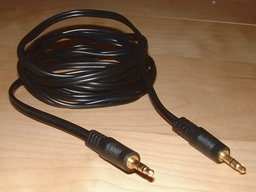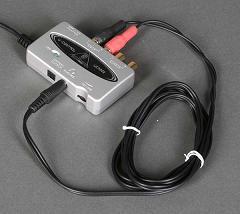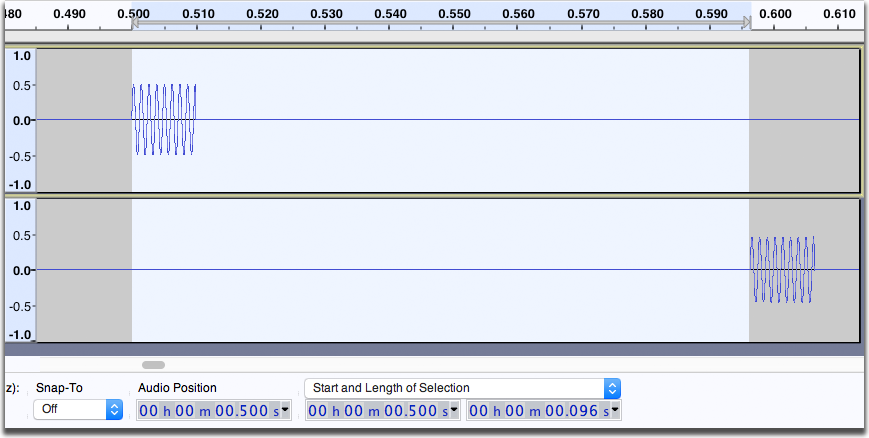Latency Test
| Latency correction is only "set and forget" if you always use the same recording device, the same sound system, the same sample rate ... every time that you record.
If that is not the case then latency correction should be tested and set each time that you record, if there's a chance that you may use a feature that requires it to be set. |
When latency adjustment is important
Latency is only important when you are using:
- overdubbing, that is, recording a new track while listening to previously-recorded track(s). You want what you play to be synchronized with the tracks you are listening to. Audacity can correct for latency, but you have to tell it what the correction amount is. You enter this correction amount in the Aufio Settings tab of the Preferences dialog
- Punch and Roll Record to quick-fix recording errors.
What you need
Using a microphone
If you are using a microphone to record overdubs then the loop-back cable method will not work for you. Instead you need to set up the microphone in front of a speaker or headphones. Do not worry, you will not get feedback because you have turned Enable audible input monitoring off.

Example of loopback using a microphone
Using a laptop computer's on-board microphone
You can just, straightforwardly, use the laptop's onboard microphone and speaker(s) for the latency test, if that is what you are planning to use for subsequent recording.
Using a desk-top computer
To use a desk-top computer you will need to connect the line input and line output ports on the computer, using a loop-back cable. The type of cable you need will depend on the way you are connecting your recording equipment to the computer.
If you are connecting your recording equipment to the line input and line output jacks on your computer you need a cable with a stereo mini-plug at each end.


A stereo loop-back cable A loop-back cable plugged in
Using an external USB audio interface
If you are not using the line input and/or line output ports on your computer but are instead using a USB audio interface device for input and/or output, plug the loop-back cable into the appropriate jacks on the USB interface.
Depending on your interface you may need a different type of loop-back cable.

Example of loopback with a USB audio adapter
| Note that using a USB microphone is not the best way to record overdubs. These microphones are great for podcasters who just want to record their voice and are not worried about syncing to music. The problem with these microphones is that the only way you can hear yourself in your headphones is by turning Enable audible input monitoring On. Enable audible input monitoring introduces its own delay (different from latency) which you will hear in your headphones. Tests on the same system used for the latency test below revealed that the Enable audible input monitoring delay was 65 milliseconds. This does not sound like much, but it is like hearing your voice coming out of speakers 70 feet away. If you are serious about overdubbing, get an inexpensive mixer and a good microphone to go with it.
For more information on overdubbing with Audacity, see our Tutorial - Recording Multi-track Overdubs |
Making the necessary settings
Recording preferences
Click on .
On the Recording tab, set the following settings:
- checked.
- not checked.
In Audacity by default using the Record button
|
Audio Settings preferences
On the Audio Settings tab, in the Latency section, set the following settings:
- Set the Latency compensation to 0 (zero), so that you get an absolute reading.
- Leave the Buffer length value at its default value.
- Click .
| The Buffer length value will affect latency, but the effect will vary between systems. 100 milliseconds is a safe value that will not put too much load on the CPU. Too low a value may put too much load on the CPU causing dropouts in the recording. If you are feeling adventurous you can repeat this test with different values for Buffer length. But in the end you should settle on a value for both Buffer length and Latency compensation and leave them there. |
Selection toolbar
In Snapping Toolbar make sure that Snap is set to "Off". Above the second and third group of numbers, make sure that is selected. Click on one of the downward-pointing arrows in the digits boxes and select .
Doing the latency test
Turn off un-necessary applications before starting the test so that the computer can mostly concentrate on playing and recording the audio.
Click on . Set "Number of Measures (bars)" to 2, and set the "Beat Sound" to . Click to generate the click track. Make sure the first track is completely selected (if you do nothing, it will be completely selected).
Now press Shift and click the Record new track button ![]() in the Transport Toolbar - the rhythm track will be played back and recorded on a new track. You will now have something like this:
in the Transport Toolbar - the rhythm track will be played back and recorded on a new track. You will now have something like this:

The top track is the original click track, the bottom track is the looped-back recording. Note the delay.
Zoom in so you can see one of the clicks in the top track and its delayed version on the bottom track.
Using Selection Tool, drag a selection starting at the start of the click in the top track and ending at the start of the delayed click in the second track.
You should see something like this (your numbers are likely to be different):

The selections go from the original click to the delayed version in the bottom track.
You can now read the latency directly from the second panel of numbers. In this case it is 0.096 seconds, or 96 milliseconds.
Click on , click on the Audio Settings tab, and enter the negative of this number in the Latency compensation box - in this case it would be -96.
Checking the result
Delete the second track by clicking the close box in its Track Control Panel.
Click the Fit to Width ![]() button to see the entire click track. Click in the Track Control Panel of the remaining track to select it, then press Shift and click the Record new track button
button to see the entire click track. Click in the Track Control Panel of the remaining track to select it, then press Shift and click the Record new track button ![]() .
.
After the recording is finished Audacity will apply the latency Correction by pushing the newly-recorded track back by the Latency Correction amount.
Zoom in on one of the clicks and verify that the clicks in the two tracks line up.

Note that there is still a tiny delay between the two tracks
You will never get it absolutely perfect. In this case we are still off by 17 samples. At 44100 samples per second that is about 0.39 milliseconds.
This is as close as we are going to get, and it is not an audible difference. This is the length of time it takes a sound wave to travel about 5 inches, and the latency will probably have natural variability greater than this each time you record.
However if you really need to, you can set the latency correction amount to a fraction of a millisecond (for example -96.4).
If you change recording or playback devices or audio host
If you change any of your recording or playback (for example, if you change from using the line input port on your computer to using a USB audio interface) or if you use the same device but change the Audio Host in Device Toolbar, then you will need to do this test again. The test you just did only applies for the specific inputs and outputs and host used during the test. Equally you should record for real with as many other applications shut down as possible, which was the scenario in which you did the test.
